Helsinki energy decision options 2015
BAU
In Business as usual -option coal remains the main fuel in Hanasaari B and Salmisaari B power plants, but the use of biofuels is increased to 5−10 % and the changes to power plants required in the new Industrial Emission Directive (IED) are made. These changes have already been approved and some are already done, so they will happen no matter what is decided about the rest of the options.
The IED sets new emission limit values (ELVs) to power plants within the European Union, which will be in effect as of 1.1.2016. In order to stay within the new ELVs, both Hanasaari and Salmisaari power plants must be renovated.[1]
The changes to be made in Hanasaari are:[1]
- Enhancing sulphur removal
- Selective catalytic reduction (SCR) or selective non-catalytic reduction (SNCR), or polttotekniset ratkaisut (combustion-technical solutions???)
- Renewing the electric filters or enhancing their operation
The changes to be made in Salmisaari are:[1]
- Enhancing sulphur removal
- Selective catalytic reduction (SCR) or selective non-catalytic reduction (SNCR), or polttotekniset ratkaisut (combustion-technical solutions???)
- Renewing the electric filters or enhancing their operation
Emissions
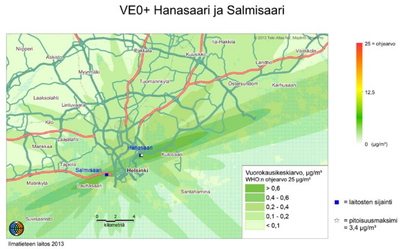
Hanasaari receives a maximum of 11 pellet deliveries per day and Salmisaari max 14/d.[1]
| Option | Fly ash (t/a) | Bottom ash (t/a) | Sulphur-removal end product (t/a) | Total (t/a) |
|---|---|---|---|---|
| Hanasaari power plant: biofuels 10 % | 59 000 | 12 000 | 8 000 | 79 000 |
| Salmisaari power plant: biofiels 10 % | 45 000 | 11 000 | 9 000 | 65 000 |
| Total | 104 000 | 23 000 | 17 000 | 144 000 |
| Emission source | CO2 kt/a | CO2-eqv kt/a (incl. fossil fuel ghg-emissions) | CO2-eqv kt/a (incl. fossil and biofuel emissions) |
|---|---|---|---|
| Power plant emissions | 2 524 | 2 533 | 2 687 |
| Emissions from fuel transport | 8 | ||
| Total | 2 540 | 2 700 |
| Power plant | NO2 (t/a) | SO2 (t/a) | Particles (t/a) |
| Salmisaari A and B | 946 | 996 | 92 |
| Fly ash (t) | Bottom ash (t) | Sulphur removal end product (t) | Total (t) | |
|---|---|---|---|---|
| Salmisaari power plants: 10 % bio, 90 % coal | 45 000 | 11 000 | 9 000 | 65 000 |
Emission coefficients
Cost
No building cost, because nothing is renovated nor built.
Usage cost
Production
How much energy?
| Electricity MW | Heat MW | Fuel | |
|---|---|---|---|
| Hanasaari | 220 | 420 | coal, pellets |
| Salmisaari | 160 | 300 | coal, pellets |
| Total | 380 | 720 |
Same table as in VE2(?), because same power plants will be in use.
Vuosaari
A new power plant is built in Vuosaari. The new plant (Vuosaari C) can burn any ratio of biofuel to coal. An energy tunnel is built from Vuosaari to Hanasaari to transport the energy to Helsinki city center.
Effects:
- Emissions
- Cost
- Traffic
- Noise (Natura 2000 -area nearby)
- Air quality
- Forests close by and further away in Finland
- Drawing closer to the coal-neutrality goal
- Running level
- Jobs in construction
- Decision-maker: Helsinki city, Helen
Description
The plans for power plant Vuosaari C are based on the assumption, that the plant will mostly use biofuels (max 80%) and coal (20%). The planned fuels are wood chips and pellets as well as small amounts of agro-biomass. The use of biochar is also possible. The plant will be fitted with a boiler developed for biofuel combustion (specifically kiertoleijupetikattila ). In order to ensure stable levels of district heat the plant is planned so, that it can function using coal only. Nevertheless plans can be made to enable the use 100 % biofuels. The recent Environmental Impact Assessment (EIA) compared the options of burning 1005 biofuels with the extreme option of burning 100 5 coal.[1]
Three options are considered for the Vuosaari powerplant (in this option, Salmisaari always burns 95% coal and 5% biofuels):
- V1: 80% biofuels, 20% coal
- V2: 100% biomass
- V3: 100% coal
At the same time Helsinki is planning a 12 kilometres long energy tunnel from Vuosaari to Hanasaari. It would be quarried in bedrock and provide district heating and possibly electricity for the needs of the whole city. The warehouses for fuel, locations for unloading trains and trucks and conveyor would be built next to the plant, and possibly a road for crossing the train tracks as well.[1]
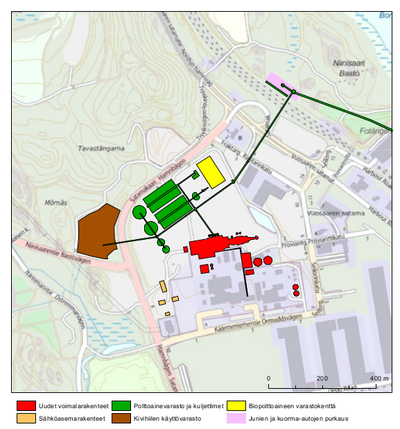
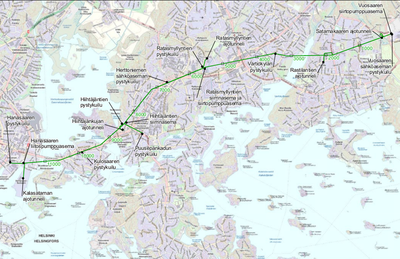
Emissions
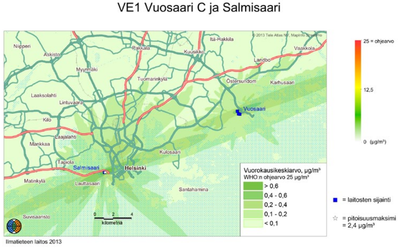
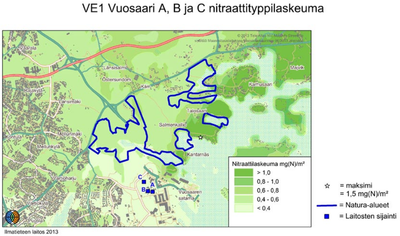
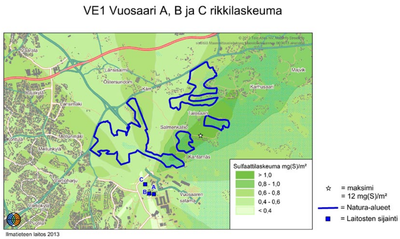
The emissions from the new plant would have two main sources: combustion of biofuels and coal and from transporting those fuels to Vuosaari C.
The fuel will be brought to the plant by ship, barge, train and truck. Ships and barges will be used to transport biofuel, coal and oil. Trains and trucks will mainly be used for transporting biofuels, trains also for transporting coal. Because the amounts of fuel required by the C-plant will be substantial, the fuel shipments will mostly be carried out using ships. Trains and trucks will be a supplementary means of transport. Shipments can be brought 24/7.[1]
Flue gases will be conducted to flue gas purification, where the particles are remowed, after which the flue gases are directed through flue gas blowers into the chimney. The ashes from the fuel are remowed as bottom ash from the furnace and as fly ash in the flue gas purification.
The power plant's flue gases are purified efficiently, so harmful effects to nearby vegetation remain slight. The great height of the chimney aids in the effective dilution of emissions in the air, so the effects on local concentrations are minimized. Judging by the atmospheric fate and transport (AFT) model's calculations, the new power plant C would cause only a minimal increase in air impurity levels in the metropolitan area. It is estimated that the fallout wont have harmful impacts on the vegetation of Natura-areas in Östersundom bird waters and Mustavuori grove nor further away north-east in Sipoonkorpi's Natura-area.[1]
Judging by the AFT-model's results, the nitrogen oxide-, sulfur oxide- or particulate matter emissions from the normal operation of Helsingin Energia's powerplants do not cause a health risk to the residents in the neighbouring area. The limit vual air quality
Leviämismallilaskelmien tulosten perusteella voidaan arvioida, että Helsingin Energian voimalaitosten normaalitoiminnan typenoksidi-, rikkidioksidi- tai pienhiukkaspäästöt eivät aiheuta terveydellistä riskiä lähialueen asukkaille, sillä terveyden suojelemiseksi annetut ilmanlaadun ohje- ja raja-arvot alittuvat kaikissa tarkasteluvaihtoehdoissa. Leviämislaskelmien tuloksia arvioitaessa on otettava huomioon, että tässä työssä ei ole tarkastelu laitosten mahdollisia päästöjä häiriötilanteessa eikä voimalaitosten ja alueen muiden päästölähteiden yhteisvaikutusta alueen ilmanlaatuun.[1]
| Power plant | NO2 (t/a) | SO2 (t/a) | Particles (t/a) |
|---|---|---|---|
| Vuosaari C | 853 | 853 | 57 |
| Vuosaari A and B | 550 | - | - |
| Total | 2 349 | 1 849 | 149 |
| Sub-option | Fly ash (t) | Bottom ash (t) | Sulphur removal end product (t) | Total (t) |
|---|---|---|---|---|
| V1 80 % bio, 20 % coal | 59 000 | 10 000 | - | 69 000 |
| V2 100 % bio (10 % pellet, 90 % chips) | 52 000 | 9 800 | - | 62 000 |
| V3 100 % coal | 82 000 | 52 000 | - | 134 000 |
| CO2, kt/a | CO2-ekv, kt/a (incl. fossilfuel ghg emissions) | CO2-ekv, kt/a (incl. fossilfuel and biofuel emissions) | |
|---|---|---|---|
| V1 powerplant emissions | 1 468 | 1 402 | 3 061 |
| V2 powerplant emissions | 1 073 | 1 114 | 3 090 |
| V3 powerplant emissions | 2 722 | 2 882 | 2 947 |
| V1 fuel transport emissions | 15 | ||
| V2 fuel transport emissions | 23 | ||
| V3 fuel transport emissions | 6 | ||
| V1 total emissions | 1 480 | 3 080 | |
| V2 total emissions | 1 140 | 3 110 | |
| V3 total emissions | 2 890 | 2 950 |
Cost
Building cost
Nyt valmistunut YVA-selvitys sivuaa energiainvestointivaihtoehtojen vaikutuksia talouteen. Vuoden lopulla valmistuva hankesuunnitelma ottaa talousvaikutuksiin tarkemmin kantaa. Uusi voimala olisi luultavasti tuplasti kalliimpi investointi kuin vanhojen voimaloiden muutostyöt. Taloudellisten vaikutusten arviointi ei kuitenkaan ole yksinkertaista. Vuosaaren voimalan käyttö tulisi vuosittain kymmeniä miljoonia euroja kakkosvaihtoehtoa halvemmaksi. Helsingin kaupunki häviää rahaa myös, jos Hanasaareen ei pystytäkään rakentamaan asuinaluetta suunnitellusti.[2]
Itse voimala maksaa arviolta noin 650 miljoonaa euroa, energiatunneli 180 miljoonaa. Arvio kokonaiskustannuksista 1,2 miljardia euroa (vuodelta 2011).[3]
Usage cost
Mikäli Vuosaaren C-voimalaitos käyttäisi 100 %:sesti biopolttoaineita (suhde 90 % metsähaketta, 10 % pellettiä), niin se tarkoittaa polttoainemääränä vuodessa 1,8 miljoonaa tonnia haketta ja 103 000 tonnia pellettiä.
Mikäli biopolttoaineen osuus olisi 80 % (suhde 90 % metsähaketta, 10 % pellettiä), tarkoittaisi se polttoainemääränä vuodessa 1,46 miljoonaa tonnia haketta, 82 000 tonnia pellettejä ja 140 000 tonnia kivihiiltä.
Mikäli Vuosaaren C-voimalaitos käyttäisi pelkästään kivihiiltä, sitä tarvittaisiin vuodessa 660 000 tonnia.[1]
Puupelettien vientihinta on 133 €/t [1]
According to this page, the thermal coal CAPP price is about 50 €/metric tonne.
| Kivihiili | Metsähake | Puupelletti | ||
| Polttoaineen kulutus | t/h | 0–108 | 0–334 | 0–178 |
| Polttoaineen kulutus | m3/h | 0–135 | 0–1 113 | 0–255 |
Calculations:
If 100% coal is used in Vuosaari power plant
- 660 000 t/a * 50 €/t = 33 000 000 €/a
If only 20% coal was used:
- coal: 140 000 t/a * 50€/t = 7 000 000 €/a
- pellets: 82 000 t/a * 133 €/t = 10 906 000 €/t
- hake: 1 460 000 t/a * €/t =
If only biofuels were used:
- hake: 1 800 000 t/a * €/t =
- pellets: 103 000 t/a * 133 €/t = 13 699 000 €/a
Production
Vuotuinen polttoaineen kulutus tulee olemaan noin 4 TWh riippuen vuodesta sekä laitoksen ajotavasta.[1] Uuden voimalaitoksen kaukolämpöteho olisi noin 350 MW ja sähköteho noin 200 MW. [4]
Noin 40–50 % lämmöstä siirtyy tulipesässä tulipesän seiniin ja mahdolliseen tulipesätulistimeen. Loppu lämpö siirretään konvektio-osassa.[1]
Effects to Natura 2000 area
Vallitseva tuulensuunta on lounaasta. Sataman melumuuri ja ennen kaikkea Niinisaaren metsäinen vyöhyke rajoittavat päästöjen leviämistä koilliseen ja mm. Natura-alueelle. Kasvillisuus sitoo pölyä erityisesti kesäaikaan.[1]
Hanasaari shutdown
Hanasaari power plant is shut down and demolished. Apartment buildings are constructed in its place.
Effects:
- Emissions
- Cost
- Land use near city center
- Market rates for apartments in Helsinki
- Quality of inner city environment
- Running level
- Jobs in construction
- Decision-maker: Helsinki city, Helen
Emissions
Ei päästöjä?
Cost
Hyöty?
Hanasaari 40 biofuel
Hanasaari power plant is renovated to burn 40% biofuels among coal.
Effects:
- Emissions
- Cost
- Forests around Finland
- Running level
- Economy of cities selling biofuels
- Jobs in construction
- Decision-maker: Helsinki city, Helen

Emissions
Hanasaaren voimalaitokselle pelletti tuodaan pääasiassa laivoilla. On arvioitu, että Hanasaareen tulisi noin 18 autokuljetusta pellettiä vuorokaudessa. Hanasaareen on vuodessa arvioitu tulevan yhteensä noin 100 alusta, joka sisältää sekä pelletti- että kivihiilikuljetukset.[1]
| NO2 (t/a) | SO2 (t/a) | Particles (t/a) | |
| Hanasaari B | 1 224 | 1 224 | 122 |
| Lentotuhka (t/a) | Pohjatuhka (t/a) | Rikinpoiston lopputuote (t/a) | Yhteensä (t/a) | |
| Hanasaari power plant: 40 % biofuels, 60 % coal | 40 000 | 9 000 | 6 000 | 54 000 |
| CO2, kt/a | CO2-eqv, kt/a (incl. fossilfuel ghg-emissions) | CO2-ekv, kt/a (incl. fossilfuel and biofuel emissions) | |
| Power plant emissions | 1 594 | 1 606 | 2 837 |
| Fuel transport emissions | 11 | ||
| Total | 1 620 | 2 850 |
Emission coefficients
Cost
Building cost
Pelkkä voimalaitos noin 100 miljoonaa, kokonaisvaikutus Helsingin Energian investointikustannuksiin 500 miljoonaa (arvio vuodelta 2011).[3]
Usage cost
Vaihtoehdossa Hanasaari 40 % biopolttoaineita käytetään noin 390 000 tonnia kivihiiltä vuodessa ja pellettiä noin 380 000 tonnia. Tuki- ja varapolttoaineena öljyä arviolta 11 500 tonnia vuodessa.[1]
Production
| Electricity MW | Heat MW | Fuel | |
|---|---|---|---|
| Hanasaari | 220 | 420 | coal, pellets |
Salmisaari 40 biofuel
Salmisaari power plant is renovated to burn 40% biofuels among coal.
Effects:
- Emissions
- Cost
- Forests around Finland
- Running level
- Economy of cities selling biofuels
- Jobs in construction
- Decision-maker: Helsinki city, Helen
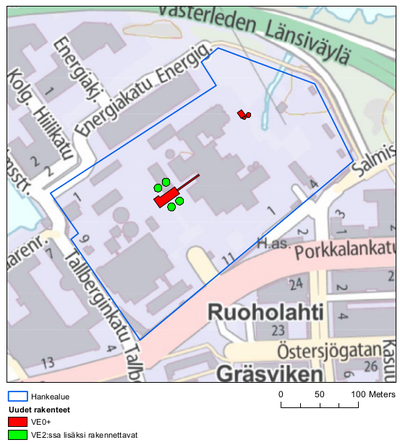
Kuvaus
Salmisaaren voimalaitokselle pelletit tulevat autokuljetuksilla. On arvioitu, että Salmisaareen tulisi noin 53 autokuljetusta pellettiä vuorokaudessa. Helsingin Energia selvittää myös kuljetusvaihtoehtoa, jossa Salmisaaressa käytettäviä pellettejä tuotaisiin myös Hanasaaren sataman kautta. Jos kaikki Salmisaaressa käytettävät pelletit kuljetettaisiin Hanasaaren kautta, sen satamaan kulkisi vuosittain noin 90 pelletti- ja kivihiilialusta enemmän, kuin muutoin.[1]
Päästöt
| Power plant unit | NO2 (t/a) | SO2 (t/a) | Particles (t/a) |
| Salmisaari A and B | 946 | 996 | 92 |
| Lentotuhka (t/a) | Pohjatuhka (t/a) | Rikinpoiston lopputuote (t/a) | Yhteensä (t/a) | |
| Salmisaari power plant: 40 % biofuels, 60 % coal | 30 000 | 8 000 | 6 000 | 44 000 |
| CO2, kt/a | CO2-eqv, kt/a (incl. fossilfuel ghg-emissions) | CO2-ekv, kt/a (incl. fossilfuel and biofuel emissions) | |
|---|---|---|---|
| Power plant emissions | 1 594 | 1 606 | 2 837 |
| Fuel transport emissions | 11 | ||
| Total | 1 620 | 2 850 |
Salmisaaressa käytetään kivihiiltä noin 290 000 tonnia vuodessa ja pellettiä noin 280 000 tonnia. tuki- ja varapolttoaineena öljyä arviolta 11 500 tonnia vuodessa.[1]
| Electricity MW | Heat MW | Fuel | |
|---|---|---|---|
| Salmisaari | 160 | 300 | coal, pellets |
Cost
Production
Loviisa nuclear CHP
A new nuclear power plant is built in Loviisa and used for district heating in Helsinki.
Effects:
- Emissions
- Cost
- Nuclear waste
- Perceived safety
- Running level
- Jobs in construction
- Decision-maker: Helsinki city, Fortum, Loviisa city?
Neste excess heat
Excess heat from Neste's oil refinery in Porvoo is used for district heating in Helsinki.
Effects:
- Cost
- Running level
- Jobs in construction
- Decision-maker: Helsinki city, Neste
Decentralised energy production
Small-scale energy production units are built around Helsinki, such as heat pumps, geothermal and sun panels, for producing energy for a single building.
Effects:
- Emissions
- Cost
- Running level
- Tourism & Finland's imago
- Jobs in construction
- Jobs in research?
- Decision-maker: Helsinki city, Citizens
Large heat pumps
Heat pumps are installed to draw large amounts of heat from the Gulf of Finland (similar system as in Stockholm) or from deep drilled hole from the ground (similar system as piloted in Espoo).
Effects:
- Emissions
- Cost
- Baltic sea
- Running level
- Environmental and political concerns
- Tourism & Finland's imago
- Jobs in construction
- Decision-maker: Helsinki city
Energy saving
Buildings in Helsinki are renovated, big campaigns to affect attitudes are organised and zero-energy houses are built to reduce the consumption of power significantly.
Effects:
- Emissions
- Cost
- Tourism & Finland's imago
- Running level
- Jobs in construction
- Decicion-maker: Helsinki city, Citizens
See also
References
- ↑ 1.00 1.01 1.02 1.03 1.04 1.05 1.06 1.07 1.08 1.09 1.10 1.11 1.12 1.13 1.14 1.15 1.16 1.17 1.18 1.19 1.20 1.21 1.22 1.23 1.24 1.25 1.26 1.27 1.28 1.29 1.30 1.31 1.32 1.33 1.34 1.35 1.36 1.37 Helsingin Energian biopolttoaineiden käytön lisääminen, Helsinki YVA 2013
- ↑ Helsingin Sanomat: Helsingin vaihtoehdot: Kallis voimala luonnonsuojelualueen viereen tai Hanasaari ilman asuntoja
- ↑ 3.0 3.1 Helsingin Sanomat: Näistä isoista investoinneista päätetään
- ↑ Helsingin Energia
- ↑ Helen: Hanasaaren voimala